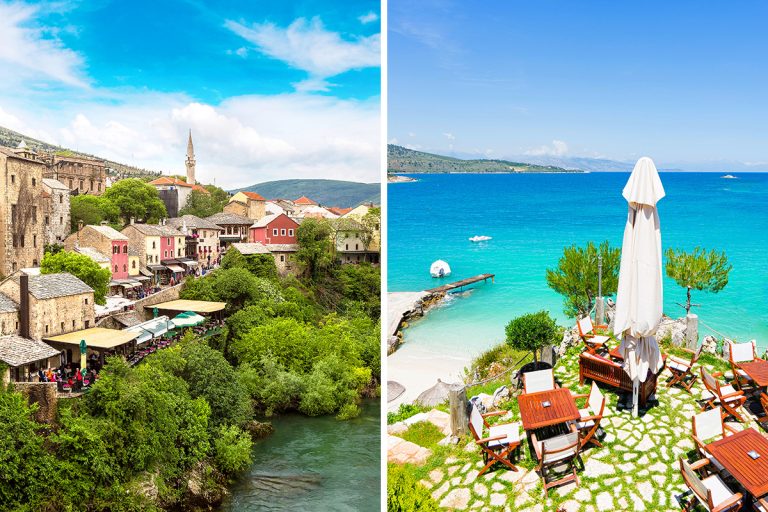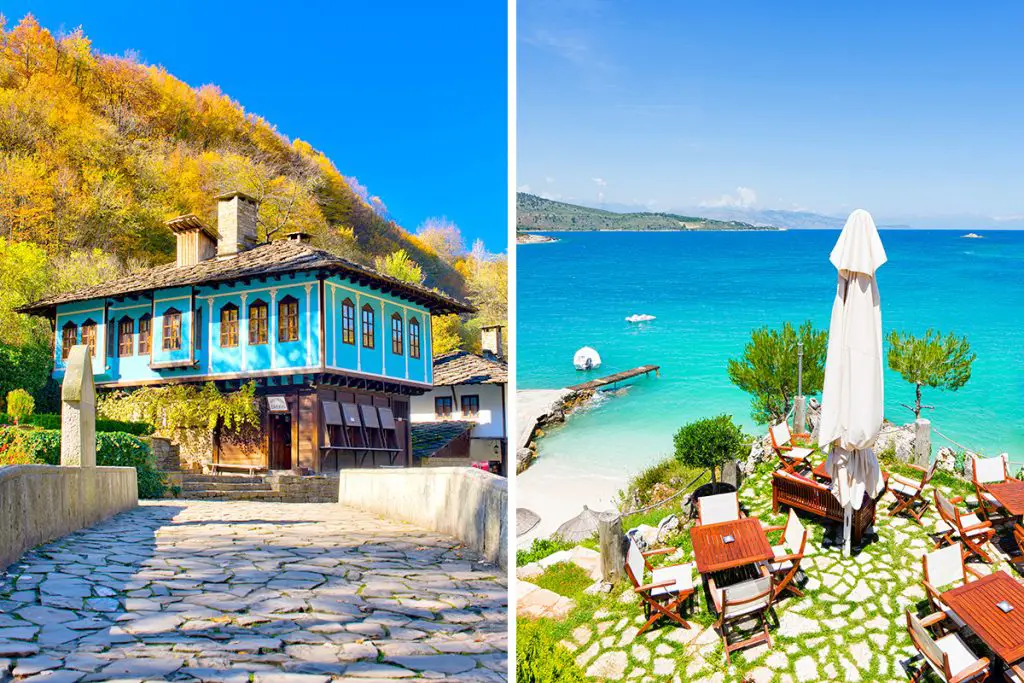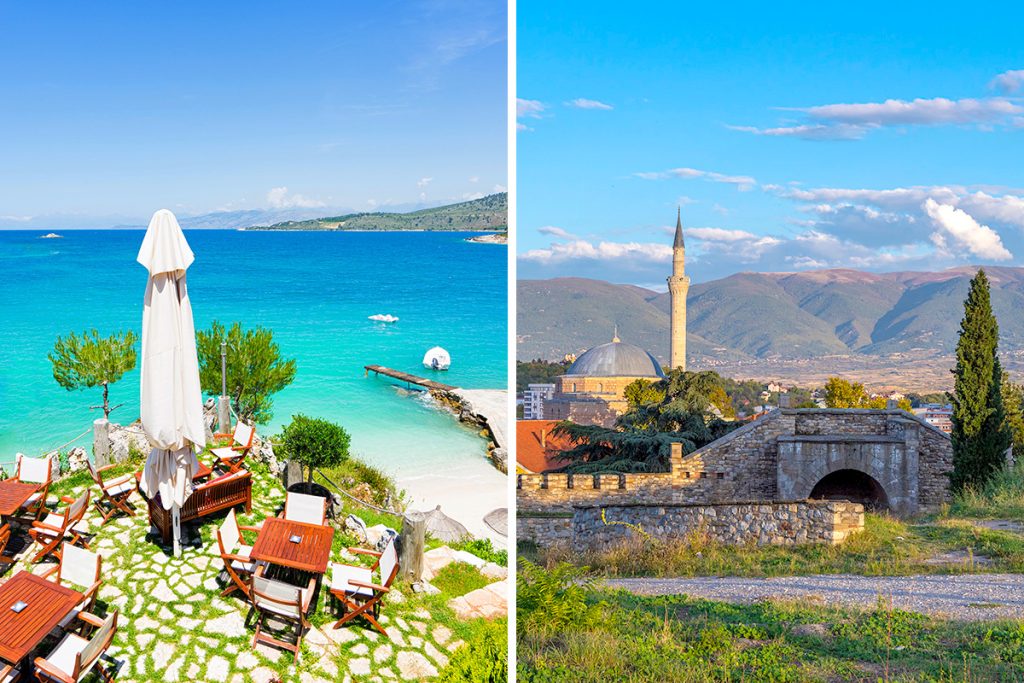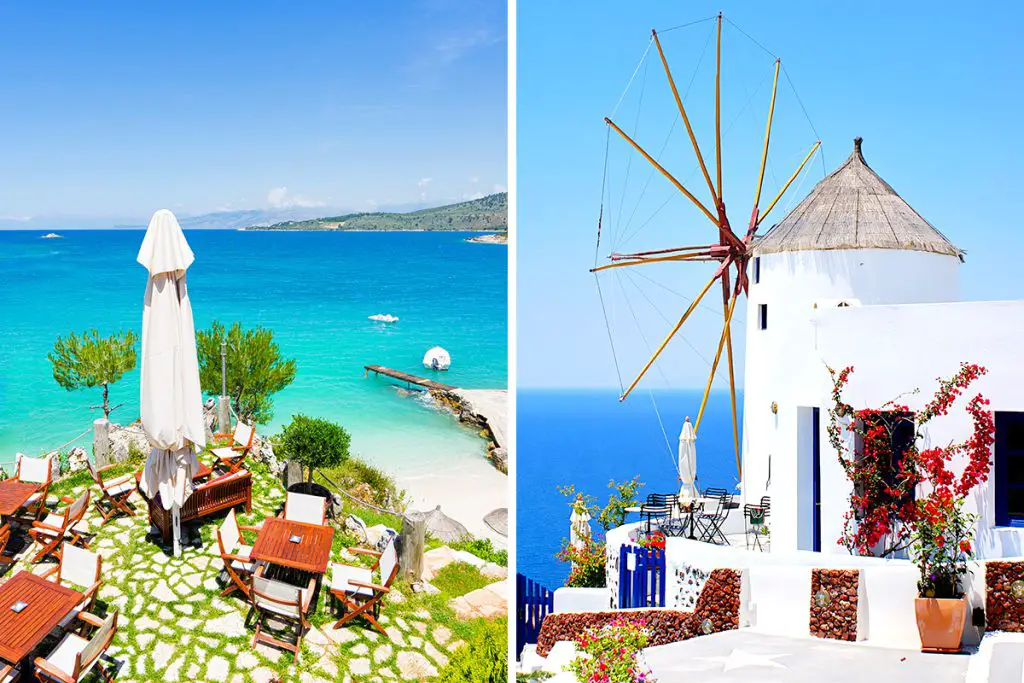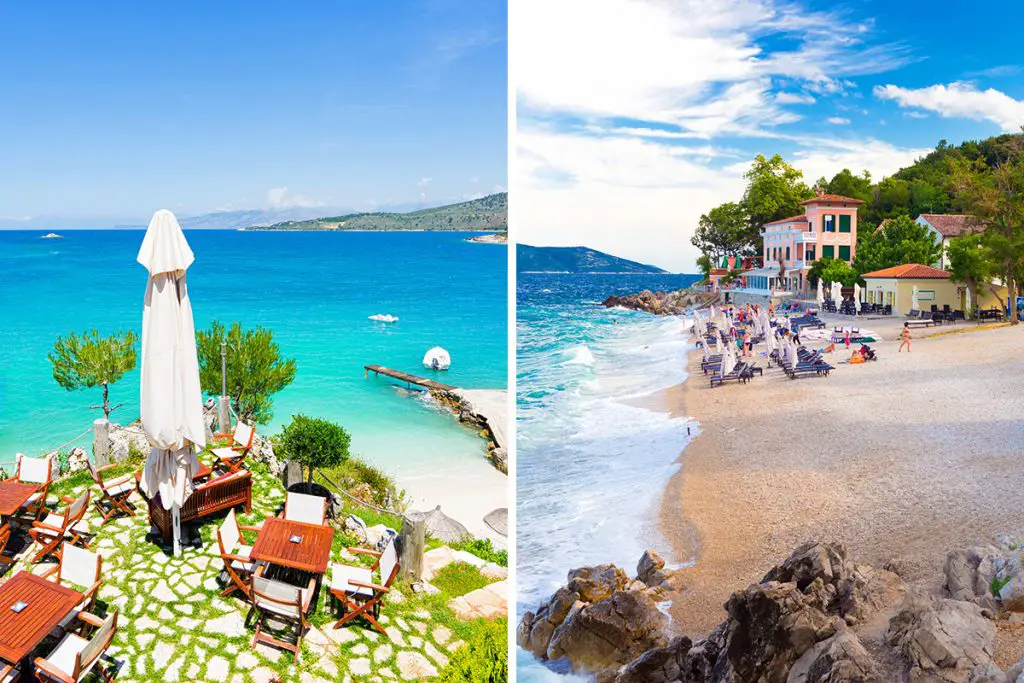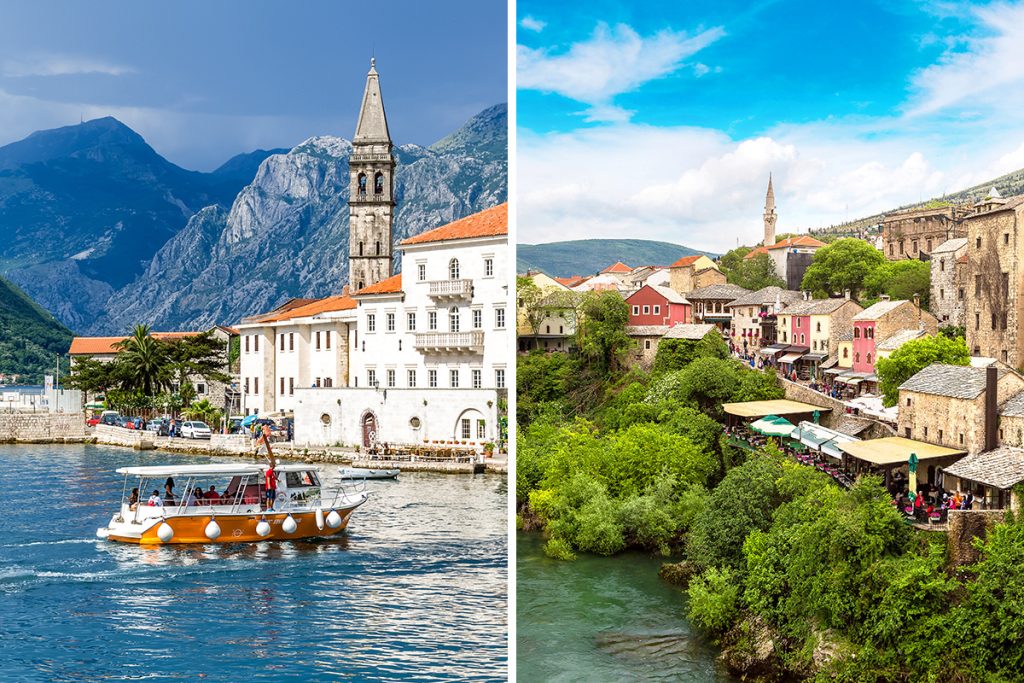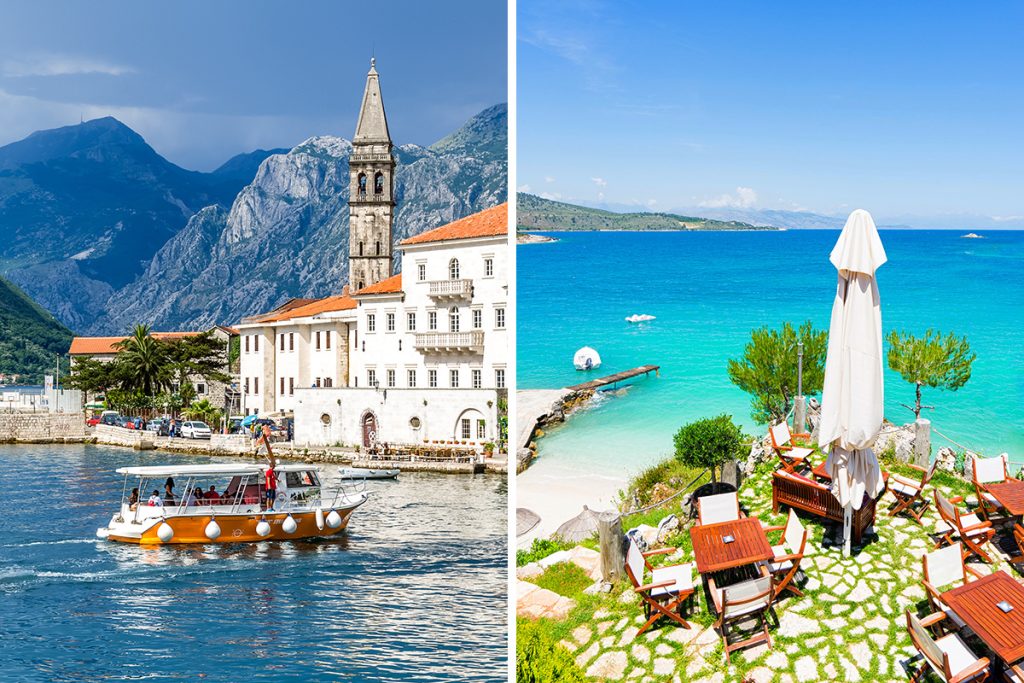The dilemma of choice is further intensified by the rich histories and vibrant cultures that both these countries boast of. The tapestry of past events and traditions that have shaped both Bosnia and Herzegovina and Albania are nothing short of captivating. As you mull over which destination to jet off to next, we invite you to explore the historical and cultural marvels that define each country.
History & Culture
The historical and cultural landscapes of Bosnia and Herzegovina and Albania are both profound and distinct. Each tells a story of resilience, evolution, and a rich tapestry of influences that have sculpted their identities over the centuries.
In Bosnia and Herzegovina, the past is a living entity. The architecture is a silent yet eloquent witness to the many eras it has seen, from the Ottoman to the Austro-Hungarian rule. Each stone in its ancient cities is a page from a long, unfolding narrative that carries the whispers of bygone eras.
The culture here has been shaped significantly by a plethora of influences, making it a mosaic of traditions that continue to flourish today.
On the other hand, Albania’s history is a vibrant blend of various civilizations that have left their mark on its soil. From ancient Illyrian tribes to Ottoman rulers, the narrative of Albania is a colorful medley of eras intertwined.
The modern-day culture of Albania is a testament to its ability to embrace change while holding onto its roots, giving you a taste of tradition coupled with a touch of modernity.
The juxtaposition of Bosnia and Herzegovina’s stoic historical narrative against Albania’s dynamic cultural blend is nothing short of captivating. While Bosnia and Herzegovina offers a more somber reflection on the past, Albania presents a lively picture of tradition meeting contemporary life.
Comparatively, both countries offer a rich yet distinct flavor of history and culture. While Bosnia and Herzegovina immerses you in a deep historical narrative, Albania offers a lighter, more fluid exploration of its past and cultural evolution.
In summary, the choice between Bosnia and Herzegovina and Albania transcends mere preference. It’s a dive into two diverse historical and cultural realms, each with its unique allure and tales waiting to be discovered. Your adventure in either will not just be a journey through picturesque landscapes, but a voyage through time and traditions.
Attractions & Activities
The allure of both Bosnia and Herzegovina and Albania extends beyond their rich historical tapestries, spilling over into a myriad of attractions and activities that promise a vibrant exploration for the adventurous soul. Each destination has its unique bouquet of experiences, waiting to be unfolded.
In Bosnia and Herzegovina, the old town of Mostar with its iconic Stari Most (Old Bridge), is a living testament to the architectural prowess of bygone eras. Venture further and the ancient city of Pocitelj will enthrall you with its Ottoman-era architecture.
Beyond the beaten path, the adventurous at heart will find solace in the wilderness of Sutjeska National Park, Bosnia and Herzegovina’s oldest national park, where hiking trails unveil the rugged beauty of the land.
Albania, on the flip side, offers a different brand of adventure. The historical city of Gjirokastër, a UNESCO World Heritage site, invites a stroll through stone-roofed houses and ancient castle ruins.
For those yearning for a touch of the wild, the Albanian Alps provide a pristine backdrop for hiking and exploring the untouched beauty of the country. The ancient ruins of Butrint, another UNESCO World Heritage site, offer a window into the civilizations that once thrived on this land.
The spectrum of attractions and activities between Bosnia and Herzegovina and Albania exhibits a balance between the old and the new, the wild and the serene. While Bosnia and Herzegovina offers a deep dive into the architectural elegance of the past, Albania offers a blend of historical exploration and natural adventures.
In conclusion, both Bosnia and Herzegovina and Albania offer a treasure trove of attractions and activities that promise to make your journey a rich tapestry of experiences. The choice between the two hinges on whether your heart yearns for architectural marvels rooted in history or a blend of historical and natural exploration.
Beaches
The call of the coast is a charming allure that both Bosnia and Herzegovina and Albania answer, albeit in their unique styles. The stretch of shoreline that graces these nations offers a tranquil retreat and a gentle whisper of the ancient and the modern.
Bosnia and Herzegovina, with its tiny 20-kilometer (about 12.4-mile) slice of Adriatic coastline, holds the quaint town of Neum. This town, although modest, offers a serene coastal experience. The calm waters and the quiet ambiance provide a tranquil retreat from the hustle of everyday life.
On the other hand, Albania, with its extensive 476-kilometer (about 296-mile) stretch of coastline along the Adriatic and Ionian Seas, offers a plethora of beach experiences. From the pristine shores of Dhërmi to the quaint beaches of Ksamil, Albania’s coastline is a canvas of diverse beach experiences.
The stark contrast between the extensive Albanian shoreline with its variety of beach experiences, and the serene, undisturbed Bosnian coastline, presents a clear difference in the beach experiences awaiting in these destinations.
Albania’s long coastline provides a vast playground for beach lovers, while Bosnia and Herzegovina’s coastline is a quiet retreat for those seeking solace by the sea.
The choice between the tranquil Bosnian coastline and the vibrant Albanian beaches boils down to personal preference. Each offers a unique charm and a promise of a serene retreat amidst nature’s beauty.
Eating, Drinking & Nightlife
The culinary journey and the nighttime whimsy are essential facets of the cultural exploration when venturing into new lands. Bosnia and Herzegovina and Albania, with their distinct traditions, offer a spectrum of experiences that tantalize the palate and enliven the spirit.
In Bosnia and Herzegovina, the eating scene is a delightful plunge into hearty meals that echo the country’s rich history. With a strong emphasis on meats, dishes like Ćevapi (small grilled minced meat) and Burek (meat-filled flaky pastry) are staples that offer a taste of the traditional Bosnian fare.
On the contrary, Albania offers a Mediterranean flair with its cuisine. A cornucopia of fresh vegetables, seafood, and olive oil characterizes Albanian meals. Dishes like Tavë Kosi (baked lamb with rice) and Fërgesë (peppers with tomatoes and cottage cheese) provide a vibrant taste palette that is both nutritious and delightful.
Venturing into the drinking culture, Bosnia and Herzegovina has a deep-rooted coffee culture, with coffeehouses being central social hubs. The ritual of enjoying a Bosnian coffee, which is akin to Turkish coffee, is an experience in itself.
In Albania, the drinking culture is more varied. Alongside coffee, the country has a thriving scene of local wineries and breweries. Raki, a traditional Albanian brandy, is a popular choice among locals and offers a warm embrace of the country’s spirited essence.
The nightlife in Bosnia and Herzegovina is a low-key affair with a focus on intimate gatherings in quaint cafes and bars. The gentle hum of conversation under a canopy of stars is the usual nighttime melody.
Albania, however, buzzes with a more vibrant nightlife. The cities come alive as the sun sets, with a blend of modern clubs and traditional taverns offering a lively night scene.
In essence, the culinary and nocturnal experiences in Bosnia and Herzegovina and Albania are as diverse as their histories. Whether it’s the comforting embrace of traditional Bosnian meals and quiet nights or the lively allure of Albanian cuisine and vibrant nights, the choice is a delightful dilemma awaiting your exploration.
Shopping
The allure of discovering unique souvenirs, local crafts, and fashion is an integral part of the adventure that Bosnia and Herzegovina and Albania offer. Each destination holds its unique charm and a plethora of shopping experiences that promise to delight the curious shopper.
Bosnia and Herzegovina, with its rich history, reflects its heritage in the myriad of crafts available. The cobbled streets of Baščaršija, Sarajevo’s old bazaar, are lined with quaint shops offering handmade copperware, traditional jewelry, and intricate textiles. The craftsmanship displayed is a testament to the country’s rich cultural tapestry.
On the other side, Albania, with its blend of the old and new, offers a mix of traditional crafts and modern fashion. The markets in Krujë are famous for their authentic Albanian souvenirs, antique items, and traditional costumes. Meanwhile, the streets of Tirana are sprinkled with modern boutiques showcasing contemporary fashion and accessories.
The shopping experience in Bosnia and Herzegovina is akin to a journey through time, with each item holding a story of the past. Authenticity and traditional craftsmanship are the hallmarks of shopping in this land.
In contrast, shopping in Albania is a dance between tradition and modernity. The markets offer a rich display of Albania’s heritage, while the boutiques offer a taste of its contemporary lifestyle.
In summation, the shopping landscapes in Bosnia and Herzegovina and Albania offer a rich exploration of their cultural identities. Whether it’s the traditional crafts of Bosnia or the blend of old and new in Albania, each shopping excursion promises to be a delightful exploration of the local lifestyle and creativity.
Accommodation
When exploring new territories, the essence of hospitality can significantly impact the overall experience. Both Bosnia and Herzegovina and Albania offer a range of accommodation options, each reflecting the unique charm and traditions of the respective regions.
In Bosnia and Herzegovina, the accommodation spectrum ranges from quaint guesthouses to luxurious hotels. The old town of Mostar and the capital city Sarajevo, boast charming guesthouses that reflect the rich history and architectural beauty of the region. Traditional Bosnian hospitality shines through, offering a warm, homey ambiance.
Albania, on the other hand, provides a mix of traditional lodgings and modern hotels. The capital, Tirana, and coastal towns like Saranda, feature contemporary hotels with modern amenities. Yet, the charm of traditional Albanian hospitality is retained in family-run hotels and guesthouses, especially in historical towns like Gjirokastër.
The authenticity of Bosnia and Herzegovina’s accommodation provides a cozy retreat amidst historical settings. It’s an invitation to step back in time while enjoying the comforts of warm hospitality.
In contrast, Albania’s accommodation scene offers a blend of modern conveniences with a touch of traditional hospitality. It’s a juxtaposition that allows for both a comfortable and culturally rich lodging experience.
In a nutshell, whether enveloped in the historical charm of Bosnia and Herzegovina or the modern yet traditional ambiance of Albania, the hospitality and accommodation options in both countries promise a welcoming stay that adds to the allure of the adventure.
Family-Friendliness & Children’s Activities
Creating cherished memories with family is a treasured aspect of travel. Both Bosnia and Herzegovina and Albania extend a warm welcome to families, offering a range of activities that are engaging for children and adults alike.
In Bosnia and Herzegovina, the adventure begins with exploring the old towns, where children can marvel at the ancient architecture and enjoy open spaces. The country also offers numerous nature parks and reserves, like Sutjeska National Park, where families can enjoy hiking and exploring the natural beauty.
Albania equally beckons with a promise of family fun. The historical sites like the ancient ruins of Butrint provide an educational adventure for children. Additionally, the country’s picturesque countryside is perfect for family hikes and outdoor activities.
The essence of family-friendliness slightly differs between Bosnia and Herzegovina and Albania. While Bosnia and Herzegovina provides a calm and educational environment, Albania offers a blend of learning and active outdoor enjoyment.
Both countries, however, prioritize family engagement and offer a variety of activities that promise to keep both the young and the old entertained and enriched.
Getting There & Getting Around
The journey to and through a new destination is the preamble to the adventure awaiting. Both Bosnia and Herzegovina and Albania have their unique infrastructures that facilitate movement to and within the countries.
Getting to Bosnia and Herzegovina is facilitated through its two international airports in Sarajevo and Mostar. The country is also accessible by road from neighboring countries, with well-maintained highways making the journey relatively smooth.
On the flip side, Albania is served by its main international airport in Tirana. Additionally, ferry services from Italy across the Adriatic Sea offer another picturesque route into the country.
Once within Bosnia and Herzegovina, the public transportation system, which includes buses and trains, offers a reliable way to explore the country. However, renting a car might provide a more flexible way to discover the hidden gems at your own pace.
In Albania, the bus system is the primary mode of public transport, connecting major cities and towns. Car rentals are also a popular choice for those looking to explore the country in-depth.
The ease of access and movement within Bosnia and Herzegovina and Albania are reflective of the countries’ openness to visitors. Whether arriving by air or road, and moving around by public transport or rented car, the journey is part of the adventure that adds to the charm of exploring these beautiful countries.
Weather
The essence of a journey is often intertwined with the rhythm of the weather. Bosnia and Herzegovina and Albania, seated in the Southeastern part of Europe, experience varying climatic patterns that paint each destination with unique hues.
Bosnia and Herzegovina experiences a continental climate. The summers, from June to August, are warm with temperatures ranging between 75°F to 95°F (24°C to 35°C). Winters, from December to February, are cold and snowy, especially in the mountainous areas, with temperatures often dropping to 32°F (0°C) or below.
On the contrary, Albania enjoys a Mediterranean climate along its coastline, while a continental climate prevails inland.
Summer temperatures in coastal areas between June and August hover around 80°F to 95°F (27°C to 35°C), while inland areas get significantly warmer. Winters are mild along the coast with temperatures rarely dropping below 50°F (10°C), while inland areas experience colder temperatures.
The transitional seasons of spring and autumn are mild and pleasant in both countries, offering a comfortable travel experience. However, Albania’s coastal areas provide a longer season of mild weather compared to the inland and mountainous regions of Bosnia and Herzegovina.
The variation in climatic conditions between Bosnia and Herzegovina and Albania provides a palette of experiences. While Bosnia and Herzegovina offers a taste of crisp winter and a warm summer, Albania provides a more temperate climate, especially along its coastline.
In summary, the weather plays a pivotal role in molding the experience in Bosnia and Herzegovina and Albania. The choice between the continental climate of Bosnia and Herzegovina and the Mediterranean allure of Albania’s coast adds another layer to the adventure awaiting.
Safety
Safety is a paramount concern that shapes the contours of travel plans. Both Bosnia and Herzegovina and Albania have their unique safety profiles that warrant consideration.
In general terms, Bosnia and Herzegovina is considered to be a safe country for travelers. The crime rates are relatively low, and the locals are known for their hospitality towards visitors.
Similarly, Albania is also perceived as a safe destination with low crime rates against tourists. The locals are friendly, and the country is steadily gaining popularity among travelers.
On a related note, it’s essential to consider the driving conditions in both countries. Bosnia and Herzegovina has mountainous terrain, which can be challenging to navigate, especially in winter. Albania, too, has its share of rugged terrain, and the driving standards may vary from what one might be accustomed to.
Both countries have made strides in enhancing safety and ensuring that visitors have a pleasant stay. The friendly demeanor of the locals in both Bosnia and Herzegovina and Albania further adds to the sense of safety.
In summation, while both Bosnia and Herzegovina and Albania provide a safe haven for travelers, being cognizant of the driving conditions and local customs can enhance the safety of the journey.
Cost
The cost of adventure is often a deciding factor in choosing a destination. Bosnia and Herzegovina and Albania, being relatively affordable European destinations, offer a bounty of experiences without burning a hole in the pocket.
In Bosnia and Herzegovina, the daily expenses including meals and transportation can be quite reasonable. A 3-course meal in a mid-range restaurant may cost around 24 BAM, which is approximately USD 12.96, while local transportation is also affordable.
Conversely, Albania is often cited as one of the most affordable countries in Europe. A meal in a similar mid-range restaurant may cost around 1,600 ALL, which is approximately USD 16, and the public transport fares are quite budget-friendly.
Lodging costs in both countries are relatively low compared to other European countries. A decent hotel room can be found at a reasonable price, providing a comfortable stay without stretching the budget.
The transportation costs within and between cities in both countries are quite economical, making it easy to explore the diverse landscapes and cultural landmarks.
In a nutshell, both Bosnia and Herzegovina and Albania offer a treasure trove of experiences at a cost that is friendly to the budget. Whether indulging in local cuisine, exploring historical sites, or traversing the landscapes, the adventure in both countries promises to be both enriching and economical.
Which Is Better – Bosnia and Herzegovina or Albania?
The allure of Southeastern Europe beckons the intrepid traveler with its blend of rich history, diverse cultures, and captivating landscapes.
Both Bosnia and Herzegovina and Albania, each with their unique tapestry of experiences, offer a journey into the heart of Europe’s heritage. However, the choice between the two can mold the contour of your adventure in significantly different ways.
The historical depth and cultural richness of Bosnia and Herzegovina provide a quiet, reflective retreat into the past. Its architecture and traditional crafts echo the tales of bygone eras, offering a serene exploration of the country’s heritage.
Conversely, Albania, with its lively blend of historical sites and natural beauty, offers a more vibrant and active experience. The infusion of modernity amidst historical relics provides a dynamic cultural exploration that keeps the spirit invigorated.
On the aspect of attractions and activities, Bosnia and Herzegovina’s calm and picturesque landscapes, coupled with historical towns, offer a peaceful retreat. Albania, with its range of outdoor activities and historical sites, promises a more adventurous escapade.
The call of the wild in Albania’s beautiful landscapes is a stark contrast to the reflective ambiance of Bosnia and Herzegovina’s ancient towns.
The coastline of Albania, with its variety of beach experiences, stands in vibrant contrast to the tranquil, undisturbed Bosnian coastline. The extensive Albanian shoreline promises a lively beach experience, while Bosnia and Herzegovina offers a serene retreat by the sea.
When it comes to family-friendliness and children’s activities, both countries extend a warm invitation. However, Bosnia and Herzegovina offers a more educational and calm environment, making it suitable for families seeking a peaceful retreat. Albania, with its blend of outdoor adventures and historical sites, provides a more engaging and active experience for families.
The ease of accessibility and affordability of both countries add to their allure. Given that Albania is often cited as one of the most affordable countries in Europe, it does not mean it is ahead in terms of cost. It only means that either way you lean, both blend affordability and a diverse range of experiences, making each a compelling choice for budget-conscious travelers.
In conclusion, the choice between Bosnia and Herzegovina and Albania hinges on personal preferences and the kind of experience one seeks. For a quiet, reflective, and educational journey, Bosnia and Herzegovina stands as a compelling choice. However, for a vibrant, adventurous, and cost-effective escapade, Albania holds the promise of a memorable adventure. Each country, with its unique bouquet of experiences, promises a rich and rewarding journey into the heart of Southeastern Europe.

